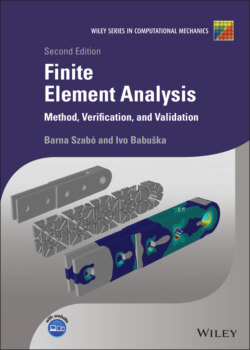Читать книгу Finite Element Analysis - Barna Szabó - Страница 41
1.5.1 Regularity
ОглавлениеLet us consider problems the exact solution of which has the functional form
(1.89)
where is an analytic or piecewise analytic function, see Definition A.1 in the appendix. Our motivation for considering functions in this form is that this family of functions models the singular behavior of solutions of linear elliptic boundary value problems near vertices in polygonal and polyhedral domains. For to be in the energy space, its first derivative must be square integrable on I. Therefore
from which it follows that α must be greater than .
In the following we will see that when α is not an integer then the degree of difficulty associated with approximating by the finite element method is related to the size of . The smaller is, the more difficult it is to approximate .
If α is a fractional number then the measure of regularity used in the mathematical literature is the maximum number of square integrable derivatives, with the notion of derivative generalized to fractional numbers. See sections A.2.3 and A.2.4 in the appendix. For our purposes it is sufficient to remember that if has the functional form of eq. (1.89), and α is not an integer, then lies in the Sobolev space where is arbitrarily small. This means that α must be larger than for the first derivative of to be square integrable. See, for example, [59].
If α is an integer then is an analytic or piecewise analytic function and the measure of regularity is the size of the derivatives of . Analogous definitions apply to two and three dimensions.
Remark 1.9 The kth derivative of a function is a local property of only when k is an integer. This is not the case for non‐integer derivatives.
